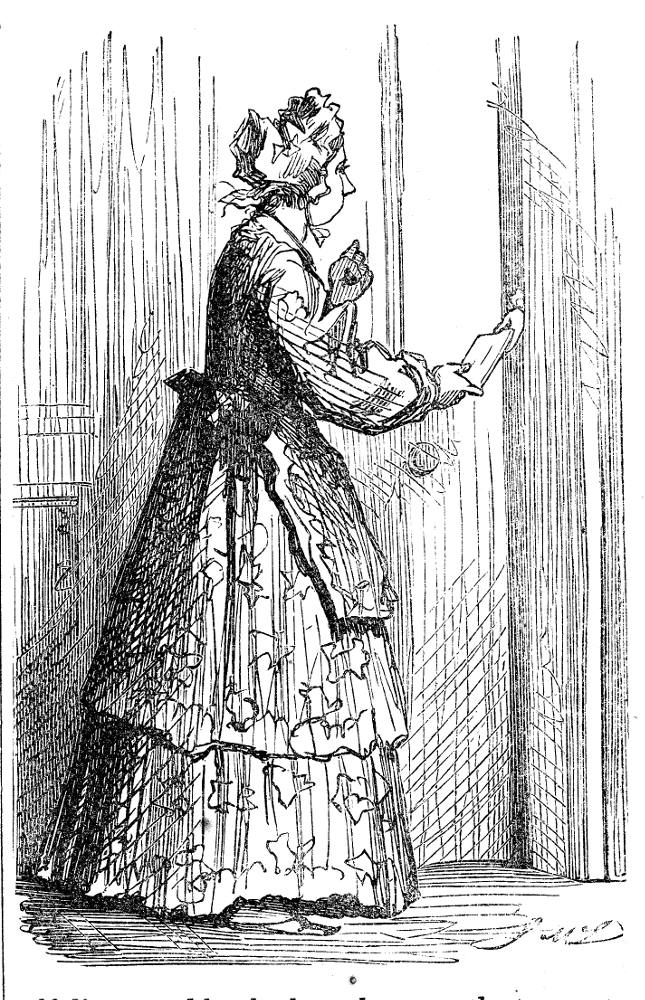

“Give me your hand, Sir.” Wood-engraving 11.6 cm high by 11.5 cm wide, or 4 ½ inches square, framed, for instalment twenty-six in the American serialisation of Wilkie Collins’s No Name in Harper’s Weekly [Vol. VI. — No. 295] Number 26, “The Fourth Scene — Aldborough, Suffolk.” Chapter VIII (page 590; p. 168 in volume), plus an uncaptioned vignettte of Mrs. Wragge’s receiving Magdalen’s note (p. 590; p. 166 in volume): 11 cm high by 5.6 cm wide, or 4 ¼ inches high by 2 ¼ inches wide, vignetted. [Instalment No. 26 ends in the American serialisation on page 575, at the end of Chapter VIII. Precisely the same number without illustration ran on 6 September 1862 in All the Year Round.]
Uncaptioned Vignette of Mrs. Lecount: Mrs. Wragge delivers the Captain’s Note
The answer returned to this note was written in crooked, blotted characters, strangely unlike Magdalen’s usually firm and clear handwriting. It only contained these words: “Give yourself no trouble about settlements. Leave the use to which he is to put his money for the future in my hands.”
“Did you see her?” asked the captain, when his wife had delivered the answer.
“I tried,” said Mrs. Wragge, with a fresh burst of tears — “but she only opened the door far enough to put out her hand. I took and gave it a little squeeze — and, oh poor soul, it felt so cold in mine!” [“The Fourth Scene — Aldborough, Suffolk.” Chapter VIII: in the American serialisation, p. 590; p. 166 in volume]
Main Illustration: Wragge strikes a Bargain with Noel Vanstone regarding the Settlement
Unutterable apprehension closed Noel Vanstone’s lips. He could only reply by an inclination of the head.
“Very good,” said the captain. “Now, sir, you may possibly have observed that I am a man of a very original turn of mind. If I have not hitherto struck you in that light, it may then be necessary to mention that there are some subjects on which I persist in thinking for myself. The subject of marriage settlements is one of them. What, let me ask you, does a parent or guardian in my present condition usually do? After having trusted the man whom he has chosen for his son-in-law with the sacred deposit of a woman’s happiness, he turns round on that man, and declines to trust him with the infinitely inferior responsibility of providing for her pecuniary future. He fetters his son-in-law with the most binding document the law can produce, and employs with the husband of his own child the same precautions which he would use if he were dealing with a stranger and a rogue. I call such conduct as this inconsistent and unbecoming in the last degree. You will not find it my course of conduct, Mr. Vanstone — you will not find me preaching what I don’t practice. If I trust you with my niece, I trust you with every inferior responsibility toward her and toward me. Give me your hand, Sir; tell me, on your word of honor, that you will provide for your wife as becomes her position and your means, and the question of settlements is decided between us from this moment at once and forever!” Having carried out Magdalen’s instructions in this lofty tone, he threw open his respectable frockcoat, and sat with head erect and hand extended, the model of parental feeling and the picture of human integrity. [“The Fourth Scene — Aldborough, Suffolk.” Chapter VIII: in the American serialisation, p. 590; p. 168 in volume]
Commentary: The Headnote Vignette’s Relationship to the Main Illustration
In the headnote vignette, we immediately wonder about the contents of the letter being hand-delivered to Mrs. Wragge in this instalment, as well, of course, as whose hand is passing the letter through the door — Magdalen’s, in fact. In the main illustration, Wragge seems to play his cards well, bolstering Vanstone’s ego as he has apparently left the property arrangements for the marriage entirely up to the prospective groom. Both sets of plates underscore the Captain’s discretion, for he knows when to act or intervene, and when to merely observe, and refrain from acting. In the main plate, the Captain acts in loco parentis, on behalf of Magdalen, who is still (supposedly) indisposed.
The illustrator does not permit us to judge Mrs. Lecount’s attitude towards the delivery; apparently Mrs. Wragge, the messenger, could not judge how the letter was being received. McLenan, however, contrasts the facial expressions of the active, upright Wragge and the passive, almost stupefied Vanstone, slumped in his armchair. His posture and facial expression both betoken astonishment. But we wonder whether the genial Captain has resolved his interlocutor’s doubts by offering him free rein on the matter of the marriage settlement. Perhaps Vanstone has been severely effected by the sip of brandy that he has just taken from his glass. His reaction to the Captain’s proposal, immediately following the moment realised, suggests that Magdalen’s ruse about the settlement is working. With the housekeeper despatched to her brother’s bedside in Zurich within the next ten days (as the Captain intends to mislead her about her brother’s having suddenly relapsed in a forged letter supposedly from the Zurich doctor), the private marriage will transpire without either her knowledge or her interference just as soon as she receives the bogus letter and is on her way to the Continent. Clearly, then, the chief connection between the two illustrations is the passing of letters.
Image scans and text by Philip V. Allingham. [You may use the images without prior permission for any scholarly or educational purpose as long as you (1) credit the person who scanned them and (2) link your document to this URL in a web document or cite the Victorian Web in a print one.]
Bibliography
Blain, Virginia. “Introduction” and “Explanatory Notes” to Wilkie Collins's No Name. Oxford World's Classics. Oxford: Oxford University Press, 1986.